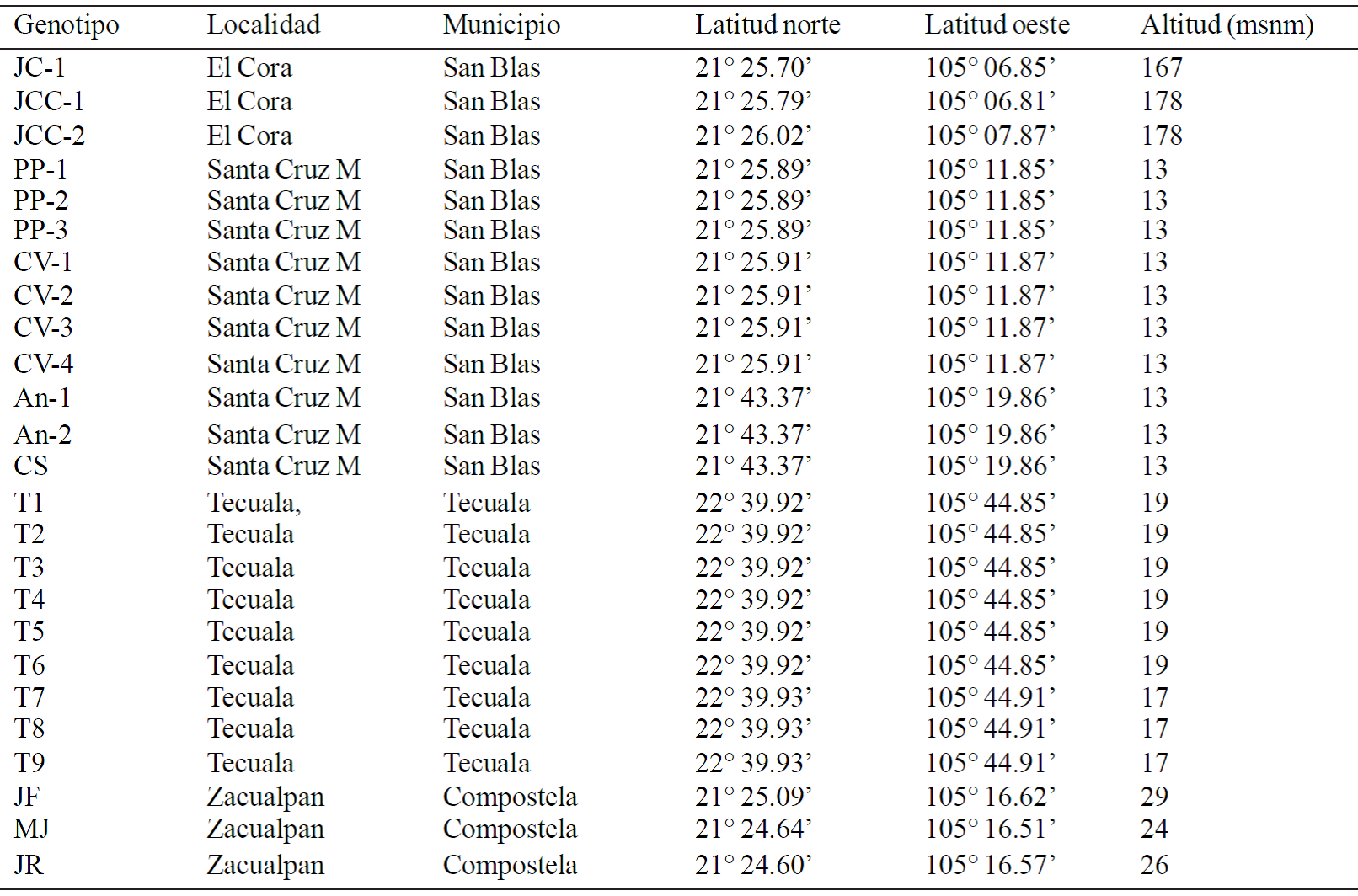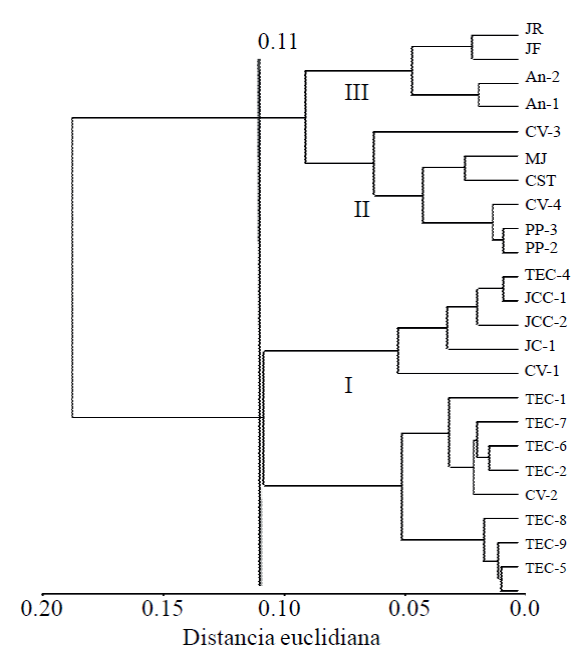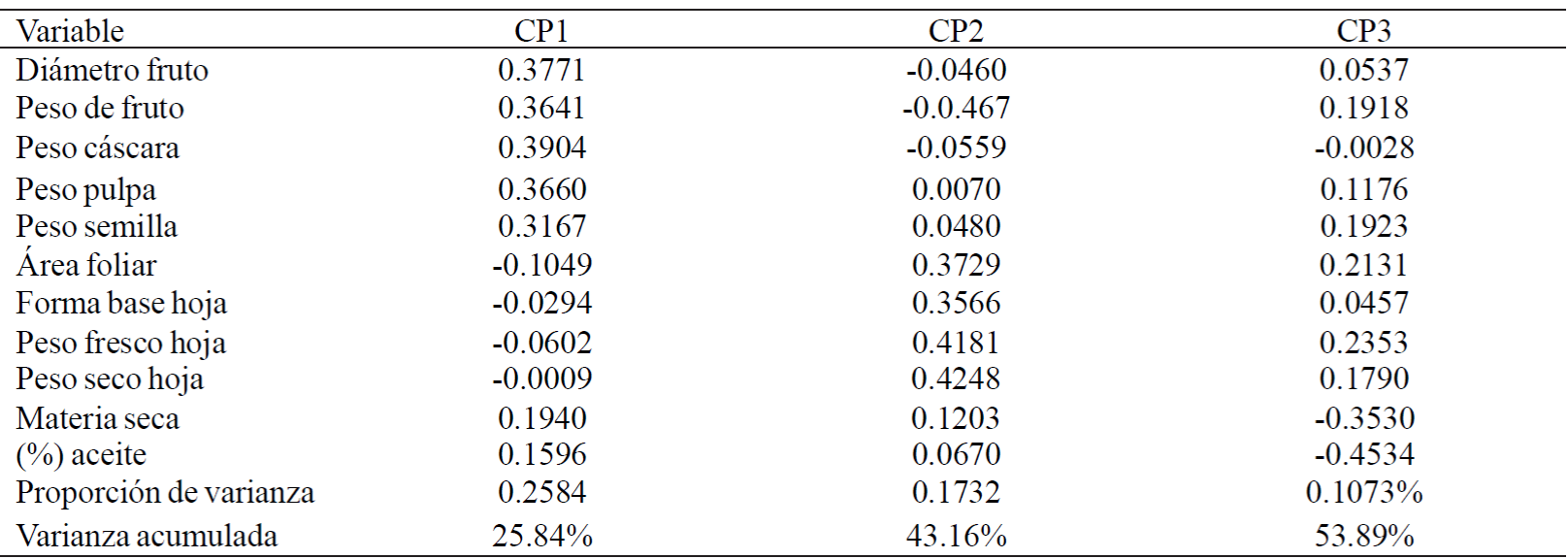Serviços Personalizados
Journal
Artigo
Indicadores
-
 Citado por SciELO
Citado por SciELO -
 Acessos
Acessos
Links relacionados
-
 Similares em
SciELO
Similares em
SciELO
Compartilhar
Revista mexicana de ciencias agrícolas
versão impressa ISSN 2007-0934
Rev. Mex. Cienc. Agríc vol.6 no.spe11 Texcoco Mai./Jun. 2015
https://doi.org/10.29312/remexca.v0i11.785
Investigation notes
Morphological characterization in native genotypes of avocado (Persea americana Mill.) of tropical climate in Nayarit, Mexico
1Universidad Autónoma de Nayarit-Unidad Académica de Agricultura. Carretera Tepic-Compostela, km 9. C. P. 63780. Xalisco, Nayarit, México. (lguzman2303@ hotmail.com; raulmetorr@yahoo.com.mx; leo.ram89@hotmail.com; pablogerman82@hotmail.com).
2Facultad de Agrobiología “Presidente Juárez”, Universidad Michoacana de San Nicolás de Hidalgo. Paseo Lázaro Cárdenas y Berlín s/n, Col. Viveros. C. P. 60170. Uruapan, Michoacán, México. (hguillenandrade@prodigy.net.mx).
3Facultad de Ciencias Agropecuarias, Universidad Autónoma del Estado de Morelos, Avenida Universidad 1001. C. P. 62210. Cuernavaca, Morelos, México.
Nayarit is part of the natural distribution are of avocado (Persea americana Mill.), so it has a great diversity of native types. The characterization and evaluation of these plant genetic resources for determining its potential as a source of germplasm utility. The aim of this study was to characterize morphologically 24 genotypes of native avocado of tropical climate in Nayarit, Mexico. Of each genotype, 10 leaves and 10 fruits at physiological maturity were taken, 23 qualitative and quantitative descriptors of leaves, fruits and seeds phenotypic characteristics were recorded; also evaluating the oil content in the pulp of fruits. Principal component analysis and cluster analysis were used. The highest variability was found in the percentage of oil with a coefficient of variation of 22.6%, with 22.4% weight epicarp, thick epicarp with 20.2%, 20.4% weight of pulp and seed weight with 23.3%. The first three principal components explained 53.8% of the total variability. At a euclidean distance of 0.11 in the dendrogram, three groups with similar morphological characteristics were generated. Fruit weight, weight of pulp, fruit diameter, weight of the epicarp, seed weight and length of leaf blade were the characters that explained better the proportion variability. These morphological features could be used as selection criteria and differentiation of genotypes of native of tropical avocado in Nayarit, Mexico.
Keywords: multivariate analysis; of tropical fruit; plant genetic resources
Nayarit es parte del área de distribución natural del aguacate (Persea americana Mill.) por lo que cuenta con gran diversidad de tipos nativos. La caracterización y evaluación de estos recursos fitogenéticos permiten determinar su utilidad potencial como fuente de germoplasma. El objetivo de este estudio fue caracterizar morfológicamente 24 genotipos de aguacate nativo de clima tropical en Nayarit, México. De cada genotipo se tomaron 10 hojas y 10 frutos en madurez fisiológica, se registraron 23 descriptores de características fenotípicas cualitativas y cuantitativas de hojas, frutos y semillas; además, se evaluó el contenido de aceite en la pulpa de frutos. Se evaluaron características fenotípicas cualitativas y cuantitativas de hojas, frutos y semillas; además, se evaluó el contenido de aceite en la pulpa de frutos. Se usaron análisis de componentes principales y de conglomerados. La mayor variabilidad se encontró en el porcentaje de aceite con un coeficiente de variación de 22.6%, peso del epicarpio con 22.4%, grosor de epicarpio con 20.2%, peso de pulpa con 20.4% y peso de semilla con 23.3%. Los tres primeros componentes principales explicaron el 53.8% de la variabilidad total. A una distancia euclidiana de 0.11 en el dendograma, se generaron tres grupos con características morfológicas similares. El peso del fruto, peso de pulpa, diámetro de fruto, peso del epicarpio, peso de semilla y longitud de lámina foliar fueron los caracteres que explicaron en mayor proporción la variabilidad. Estas características morfológicas podrían usarse como criterio de selección y diferenciación de genotipos de aguacate nativo en la zona tropical de Nayarit, México.
Palabras clave: análisis multivariado; fruto tropical; recursos fitogenéticos
The importance of existing plant genetic resources in Mexico is invaluable, because these can be used in breeding to solve basic problems of the crops in commercial exploitation. In the case of avocado, as this country a centre of origin and natural range of this species, there is variability and allows for various genetic materials (CICTAMEX, 1991).
Avocado, Persea americana Mill. (Lauraceae), is a tree that has been under cultivation in central Mexico, from at least 10 000 years ago (Storey et al., 1984; Schieber and Bergh, 1987; Téliz and Mora, 2007); also, as a result of the selection process, seed propagation and adaptation, have developed different types of avocado known as the horticultural races Mexicana, Guatemalteca and Antilana (Barrientos-Priego et al., 2007).
Currently, in Nayarit, the Antillean avocado tree is mostly grown in backyard gardens. Although, there are formal gardens with improved crop varieties, native avocado is preserved as a shade tree and hedgerows in the municipalities of Compostela, San Blas and Tecuala; these trees have been preserved mainly by the outstanding features of its fruits.
Nayarit is part of the natural distribution area of avocado Dr. Raul Medina (Pers. Comm., 2014).
So it's critical to study characterization and evaluation of these plant genetic resources to determine their potential utility as a source of germplasm in breeding of this species and to provide a basis to help define strategies for conservation and use of this species. Therefore, the objective was to characterize morphologically 24 native genotypes avocado of tropical climate in Nayarit, Mexico.
Collections of 24 genotypes of native avocado were performed in the tropical zone of Nayarit, specifically in the municipalities of Compostela, San Blas and Tecuala, at an elevation of 13-178 m (Table 1). Phenotypic characterization was done with 23 descriptors leaf, fruit and seed without sickness or physical damage. In each tree samples of 10 leaves and 10 fruits at physiological maturity were obtained.
Table 1 Native avocado genotypes (Persea americana Mill.) evaluated in the municipalities of Compostela, and Tecuala San Blas, Nayarit.

Evaluated variables
The morphological characteristics were evaluated in leaves: leaf shape, shape of base, colour, margin, shape of apex, fresh weight, dry weight and length of leaf blade and leaf area (cm2) using a leaf area integrator (LIQUOR 1600, NE, USA). Fruit variables were: fruit shape, length and diameter (mm), shape of the base, form the apex, form the pedicel, colour epicarp the exocarp thickness (mm), the epicarp weight (g) weight Fresh pulp (g) and dry matter of the pulp (g). Seed variables were: seed shape, seed weight (g). Descriptors were used of the International Plant Genetic Resources Institute, now Bioversity (IPGRI, 1995). Variable length and diameter were measured with an electronic caliper (Mitutoyo, Inc., Japan) to the nearest 0.1 cm and weight-related variables were determined with a Mettler® digital balance model AJ150, 0.001 g.
Considered an important variable quality, the percentage of oil in fruits was evaluated though not a morphological characteristic. 100 g pulp were weighed and dried in a forced air oven (LAB-LINE, Imperial II, USA) at 70 °C to constant weight. The percentage of dry matter was obtained through dry/fresh weight and weight multiplied by 100. The oil content was determined by Soxhlet extraction with a distiller, using the official method for determining oil content plant organs relationship USDA (Lee, 1981). Petroleum ether was used as solvent and four replicates were performed for each genotype.
Statistical analysis
A principal component analysis was performed. With the variables that showed more descriptive value of euclidean distances calculating the dendrogram constructed by the Ward grouping method (SAS Istitute, 2009), for maximum separation of groups by their similarities in characteristics of leaf, fruit and seed.
In most of the evaluated quantitative characteristics variability was found as evidenced by the values of the coefficients of variation (CV), which highlights the thickness of the epicarp (CV= 20.2%), the weight of the epicarp (CV= 22.4%), oil percentage (CV= 22.6%), pulp weight (CV= 20.4%) and seed weight (CV= 23.3%).
Table 2 Descriptive quantitative and statistical features of 24 native genotypes evaluated in avocado (Persea americana Mill.) in Nayarit, Mexico.

As for the quality characteristics, it is considered that the shape of fruit is a morphological indicator of importance because it is one of the features that make it attractive to avocado market consumers (Rodríguez-Medina et al., 2009). In the present study, fruit shape that prevailed was the narrow -obovate with 24.4%. In a study with native genotypes in Uruapan, Michoacan was found that the shape of fruit that stood out was the ellipsoid (32.2%), Dr. Raul Medina (Pers. Comm., 2014). These results show the diversity of existing materials avocado in Mexico and could be used as a source of germplasm in breeding of this species.
The major dimensions of length and diameter (mm) of fruit, presented the AS- 1 and AS-2 (107.41 and 106.98 g, respectively), and the smaller the Tec-1 genotype with 63.68 g genotypes. Similarly, the highest values in fruit weight corresponded to AS-1 and AS-2 (941.72 and 1 042.92 g) selections, and the least significant Tec-1 (188.13 g). Gutiérrez-Díez et al., (2009) evaluating 42 genotypes of native avocado Nuevo Leon, Mexico reported the highest fruit weight was 251.40 g and 10.53 g minor, for the largest fruit length was 12.76 cm and the lowest was 2.88 cm. Besides the genetic characteristics, these differences may be due to the different climates and altitudes where these native avocados occurred.
The dendrogram, with a cut to a euclidean distance of 0.11 (Figure 1), defined three groups based on morphological descriptors leaf, fruit and seed. Group I consisted of the genotypes Tec-1, 2, 4, 5, 6, 7, 8 and 9 Tecuala, PP -1, CV-2, CV- 1 and JC-1 of Santa Cruz de Miramar and JCC-1, JCC-2 and JC-1 of El Cora, municipality of San Blas, with characteristics of lower weight of pulp, small seed, lighter weight shell, which derives a result of lower total weight.

Figure 1 Ward minimum grouping of 24 native genotypes of avocado (Persea americana Mill.) based on morphological characteristics in Nayarit, Mexico.
The group II was integrated with MJ genotypes of Zacualpan, municipality of Compostela and CST, CV-3, VC-4, PP-2 and PP- 3 of Santa Cruz de Miramar, San Blas, had as features increased fruit weight pulp, small diameter and leaf. The group III was integrated with JF and JR genotypes Zacualpan and An-1 and An-2 of Santa Cruz de Miramar, and is characterized by greater leaf area, fresh weight and dry weight of leaf, plus greater weight and diameter fruit, and greater weight of pulp.
In the principal component analysis, variability accumulated in the first three components observed 53.8%: 25.8% explained CP1; CP2 and CP3 17.3% 10.7% (Table 3).
Table 3 Eigenvectors and proportion of the variability in the first three principal components, generated with phenotypic characteristics of fruits, seeds and leaves of 24 native genotypes of avocado (Persea americana Mill.) in Nayarit, Mexico.

CP1 variability was determined by positive values of diameter and fruit weight, weight epicarp weight of pulp and seed weight. These results are similar to those reported by López-Guzmán et al. (2012), where the CP1 was related to weight, length, width and weight of fruit pulp in native genotypes of avocado. CP2 was influenced by leaf area, leaf fresh weight, shape of the base of the leaf and leaf dry weight. In the CP3 percentage of oil and dry matter of the pulp exerted a negative influence (Table 3).
Finally, the Figure 2 shows the scattergram of the two main morphological variables of the 24 native genotypes of avocado (Persea americana Mill.) Nayarit, Mexico.
Conclusions
Three groups with similar morphological characteristics of native avocado genotypes were formed. The characteristics of fruit weight, weight of pulp, fruit diameter, shell weight, seed weight and leaf blade length, characters that better explained the morphological variability, so that these parameters could be used as a selection criterion and differentiation of native genotypes of tropical avocado in Nayarit, Mexico.
Literatura citada
Barrientos-Priego, A. F.; Muñoz-Pérez, R. B.; Reyes-Alemán, J. C.; Borys, M. W. y Martínez-Damián, M. T. 2007. Taxonomía, cultivares y portainjertos. In: el aguacate y su manejo integrado. Téliz, D. y Mora, A. (Coord.). Segunda edición. Mundi Prensa. México, D. F. 31-62 pp. [ Links ]
CICTAMEX. Fundación Salvador Sánchez Colín. 1991. Situación actual del cultivo del aguacate en México. In: hortalizas, frutos y flores. (Ed.). Año dos mil, S. A. 49-58 pp. [ Links ]
Gaona-García A, Alia- Tejacal, I.; López -Martínez, V.; Andrade-Rodríguez, M.; Colinas-León, M.T. y Villegas-Torres, O. 2008. Caracterización de frutos de zapote mamey (Pouteria sapota) en el suroeste del estado de Morelos. Revista Chapingo Serie Horticultura. 14:41-47. [ Links ]
Gutiérrez-Díez, A.; Martínez- de la Cerda, J.; García-Zambrano, E. A.; Iracheta-Donjuan, L.; Ocampo-Morales, J. D. y Cerda-Hurtado, I. M. 2009. Estudio de diversidad genética del aguacate nativo en Nuevo León, México. Rev. Fitotec. Mex. 32:9-18. [ Links ]
IPGRI (Instituto Internacional de Recursos Fitogenéticos). 1995. Descriptores para aguacate (Persea spp.). Roma, Italia. 54 p. [ Links ]
Lee, S. K. 1981. A review and background of the avocado maturity standard. California Avocado Society Yearbook. 65:101-109. [ Links ]
López-Guzmán, G. G.; Medina-Torres, R.; Guillén, A. H.; Ramírez, G. L.; Aguilar, C. J. A. y Valdivia, R. M. G. 2012. Características fenotípicas de hoja y fruto en selecciones de aguacate criollo de clima subtropical en el estado de Nayarit. Rev. Fuente. 4:56-62. [ Links ]
Rodríguez-Medina, N. N.; Rohde, W.; González-Arencibia, C.; Ramírez-Pérez, M.; Fuentes-Lorenzo, J. L.; Román-Gutiérrez, M. A.; Xiqués-Martín, X.; Becker, D. y Velázquez-Palenzuela, J. B. 2003. Caracterización morfológica, bioquímica molecular de cultivares de aguacatero (Persea americana Mill) en Cuba. In: V Congreso Mundial del Aguacate. Junta de Andalucía. Consejería de Agricultura y Pesca. Granada, Málaga. 1:47-53. [ Links ]
Sanabria, O. H. L.; García, M. A.; Díaz, H. A. y Muñoz, J. E. 2005. Caracterización morfológica en árboles nativos de guayaba en el Valle del Cauca. Acta Agronómica. 54:1-9. [ Links ]
Statistical Analysis System (SAS) Institute. 2009. SAS user’s guide. Statistics. Version 9.0. SAS Inst., Cary, NC. USA. [ Links ]
Schieber, E. and Bergh, B. 1987. Persea zentmyerii: a new species from Guatemala. California Avocado Society 1987 Yearbook. 76:199-203. [ Links ]
Storey, W. B.; Bergh, B. O.; Platt, R. G. and Miller, M. 1984. Observations on a second-generation progeny of a Mexican x West Indian cross. California Avocado Society Yearbook. 68:161-165. [ Links ]
Téliz-Ortiz, D. y Marroquín- Pimentel, F. J. 2007. Importancia histórica y socioeconómica del aguacate. In: el aguacate y su manejo integrado. Teliz, D. and Mora, A. (Coord.). Segunda edición. Mundi-Prensa. México, D.F. 3-28 pp. [ Links ]
Received: December 01, 2014; Accepted: March 01, 2015











 texto em
texto em 



